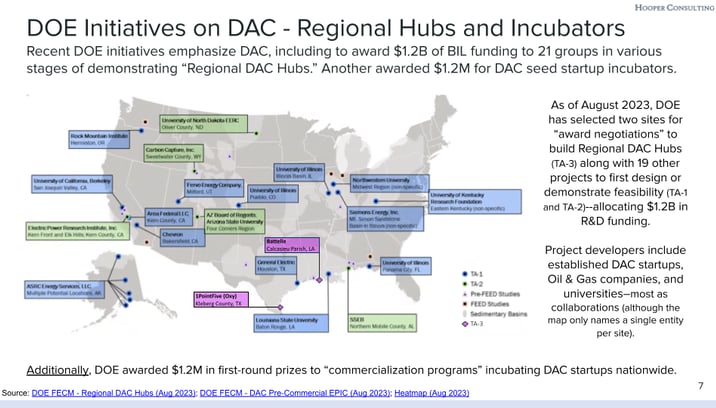Direct Air Capture
Primer on DAC Technology & Sector
CLEAN ENERGY & CLIMATE
Drew Hooper
10/10/20234 min read


Alongside rapid decarbonization, the climate science community, government, NGOs, and business leaders have concurred on the need to scale up “carbon removal” from the atmosphere, through both nature-based and technological solutions. The IPCC estimated a need to scale up to 5-16 Gt eCO2 in annual carbon removal by 2050, echoed by the State of CDR organization, McKinsey & Co., and various others.
The IEA and McKinsey & Co. identify Direct Air Capture “DAC” and Bioenergy for Carbon Capture & Storage (BECCS) as leading carbon removal methods. DAC entails capturing carbon from the air using mineral sorbents or membranes, electrochemical processes, air vacuums, etc. and the captured CO2 can can then be put to “clean” use or permanently stored. BECCS entails cultivating or aggregating biomass, and combusting it in a controlled system that captures carbon, thus producing carbon neutral energy. Other carbon removal methods include point-source capture (systems to capture carbon from industrial processes) and nature-based solutions such as afforestation, ocean alkalinization, and enhanced soil and mineralization.
The US has led out in developing DAC-favoring policy and implementation. “The Long-Term Strategy of the United States, Pathways to Net Zero” calls for 1-1.8 Gt CO2 in annual carbon removal by 2050. Policy and efforts to accelerate DAC include a Carbon Negative Earthshot initiative (research commitment to capture 1 Gt CO2 for less than $100/ton within a decade) and over $15B funding committed in programs and tax incentives for carbon removal. Close to $3.7B of this funding focuses specifically on DAC solutions, with plans to ultimately finance four demonstrating DAC regional hubs across the US in partnership with private sector providers. In August 2023, the US DOE announced $1.2B in awarded funding for 19 DAC facility pilots by private sector entities/partnerships, alongside two final stage consideration sites for these regional hubs. Another DOE program also awarded $1.2M to 14 DAC accelerator programs to incubate DAC startups across the nation.
Image Credit: ClimeWorks
A series of DAC startups have emerged as market leaders in the US and globally. At present, the largest operating DAC facility captures only 4,000 tons CO2 per year (ClimeWorks’ Orca facility in Iceland). However, multiple startups as well as oil & gas subsidiaries have projects under construction which aim to capture up to 1 Mt CO2 per year. Many of these startups and subsidiaries, whether headquartered in the US or abroad, received DOE funding to pilot DAC facilities.
Of the various carbon removal methods, DAC has received some critique for incurring significant costs. Many DAC techniques entail high energy use to operate fans and/or pump liquids continuously. Then CO2 release from mineral sorbents or membranes can require thermal heat of up to 400 C to 900 C. Finally, captured CO2 requires storage and transportation solutions, whether in containers or piping infrastructure over some distance. However, DAC companies and others interested in the climate space are innovating to reduce these costs or bypass inputs. For example, DAC startup Verdox has developed an electrochemical method to separate captured CO2 from re-usable membranes (i.e. not requiring any thermal heat). And Geothermal energy startup Fervo Energy is developing combined geothermal energy and DAC facilities, which provide abundant clean energy and excess thermal heat as well as may co-locate near to sites for underground CO2 storage.
Many of the leading DAC companies have partnered with separate entities (or a parent oil & gas company) on the "permanent storage" operations for captured CO2. CarbFix is one such partner, which injects liquified CO2 into subsurface basalts where it reacts with host rock and transforms into solidified carbonate. Other storage solutions include injection of CO2 into deep subsurface, sealed reservoirs. DAC companies also can sell captured CO2 for use/re-use. Coca Cola has purchased highly refined CO2 from DAC operations, while Neustark and CarbonCure may become purchasers of CO2 as inputs into building materials (which can both pre-empt carbon emissions of traditional construction materials and effectively store air-captured CO2). Oil & gas companies also utilize captured CO2 for "enhanced well recovery" (i.e. injecting captured CO2 into oil/gas wells, which enables extraction of more oil/gas). However, the climate science community along with government, business, and general public question the climate ethics of this practice, and in the US it qualifies for a lower tax incentive (than permanent storage).
An operating DAC facility can provide verified carbon removal and thus generate carbon credits. Companies (and individuals) can purchase carbon credits directly from DAC operators, or through marketplaces such as Carbonfuture or Puro. “Advance market commitment” coalitions deserve credit for accelerating interest in carbon removal solutions and voluntary carbon markets. Two foremost of such include the Fronter Coalition (Stripe, Alphabet, McKinsey & Co., et al. with $1B pledged) and First Movers Coalition (WEF and 113 member organizations, with over $12B pledged). The pledged funds committed by these coalitions enabled DAC startups and ventures to more readily obtain financing from investors, who had uncertainty both about technological viability and market adoption. Similarly, tech giants Microsoft, Alphabet, Amazon, Apple, and Meta along with energy companies and financial institutions have been early investors and customers in the space. In September 2023, Microsoft and Amazon made largest-to-date advance purchases of multi-year carbon removal from Heirloom Carbon (315,000 tons CO2) and 1PointFive-Oxy (250,000 tons CO2) respectively.
If carbon removal averages $50/ton (across all methods) and scales to the minimum IPCC target of 5 Gt CO2 annual carbon removal by 2050, the total addressable market for DAC would be $250B globally in 2050. An estimated serviceable addressable market for DAC could be 20% of the carbon removal market, which would size to $50B in 2050. Thus, DAC companies have long-term economic interests to forge ahead with establishing the best effective and impactful climate solutions for the world.




